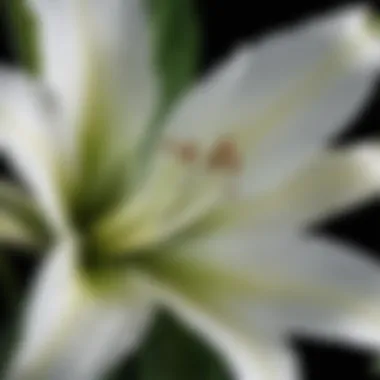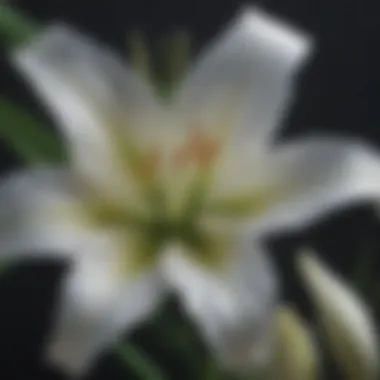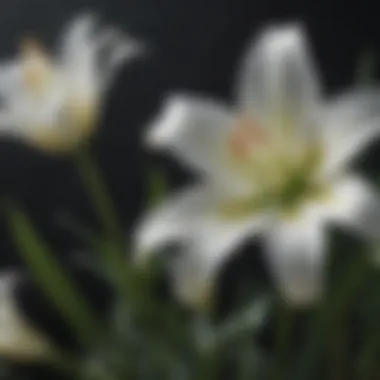The White Lily: Exploring Its Symbolism and Significance


Intro
The white lily, symbolizing purity and nobility, holds a significant place in various cultures and traditions. Its elegant appearance often captivates those who encounter it, and its historical and cultural significance weaves a rich tapestry of meanings. This article delves into the nuanced characteristics of the white lily, its symbolism across different contexts, its presence in literature and art, and practical advice on cultivation and care.
Botanical Overview
Common Name and Scientific Classification
The common name for the white lily refers primarily to the species known as Lilium candidum. This flower belongs to the Liliaceae family. It is distinct from other members of the lily family due to its unique flowering characteristics and cultural symbolism.
Physical Characteristics
White lilies are renowned for their striking, trumpet-shaped flowers that can reach up to six inches in length. The petals are typically pure white, signifying purity, and they often emit a sweet fragrance. The stems can grow quite tall, often exceeding three feet. The leaves are lance-shaped and arranged alternately along the stem.
Habitat and Distribution
White lilies are native to a variety of regions, but they thrive best in well-drained soil with ample sunlight. These plants are often found in temperate climates across Europe, but they have been widely cultivated in gardens worldwide.
Symbolism of the White Lily
The white lily carries various symbols that vary by culture and context. It signifies purity, hope, and renewal. In Christian tradition, the white lily often represents the Virgin Mary, embodying her innocence and purity. Meanwhile, in ancient Greek mythology, it was associated with the goddess Hera, symbolizing feminine strength and motherhood.
"The white lily serves as a powerful symbol of purity and renewal across cultures, making it a profound flower in both personal and artistic expressions."
Cultural Significance
White lilies have been used extensively in art and literature. From classical paintings to contemporary designs, the elegance of these flowers captures the imagination. They appear in works by artists like Claude Monet, who depicted their grace in his paintings. Furthermore, famous literary works often mention white lilies as metaphors for untainted beauty.
Cultivation and Care
Growing White Lilies
Growing white lilies can be rewarding. They prefer a sunny spot with well-drained soil. Plant the bulbs in the fall or early spring, ensuring they are at least six inches deep. Water them regularly, but avoid waterlogging, as this can cause bulb rot.
Maintenance Tips
Regular deadheading—removing spent blooms—encourages new growth and prolongs the flowering season. Fertilize these plants with a balanced fertilizer in early spring. Be mindful of pests like aphids and lily beetles, which can harm the plants.
Ecological Roles
White lilies support pollinators such as bees and butterflies. Their nectar provides essential resources for these insects, promoting biodiversity in gardens and natural habitats. Cultivating a variety of plants, including the white lily, can enhance the health of ecosystems.
Closure
The white lily transcends mere decoration, embodying profound symbolic meanings and serving vital ecological roles. By understanding its cultivation and care requirements, one can appreciate this flower not only for its beauty but also for its deeper significance across cultures.
Botanical Overview of the White Lily
The white lily serves as more than just an attractive flower. Its botanical overview provides crucial insight into its structure, growth, and natural habitat. Understanding these aspects lays a foundation for exploring its symbolism and cultural significance. The taxonomy and characteristics of the white lily illustrate how its unique features make it an excellent subject for various applications in art, literature, and gardening. This overview can inform gardeners about planting practices and contribute to ecological discussions about plant preferences and distributions.
Taxonomy and Classification
The white lily belongs to the Lilium genus within the Liliaceae family. There are several species under this genus, but the most recognized type is Lilium candidum. Classifying the white lily as a perennial plant reveals its resilience and adaptability, supporting its continued presence in diverse environments.
Physical Characteristics
Petal Structure
The petal structure of the white lily is distinct and plays a key role in its beauty. The petals are large, trumpet-shaped, and often adorned with striking patterns. This structure not only appeals visually but also attracts pollinators. A noteworthy feature is their smooth texture, allowing raindrops to roll off easily. This aids in maintaining them clean and vibrant, enhancing their aesthetic appeal for gardens and floral arrangements.
Color Variations
While the name 'white lily' implies a specific hue, this species can exhibit subtle color variations. From pure white to creamy shades, these variations can reflect different growing conditions. Notably, flower color can affect its popularity in various cultures, as shades can symbolize varying meanings. The unique transition between shades can add depth and intrigue to floral displays, enhancing their appeal in gardens.


Growth Habit
White lilies typically exhibit an upright growth habit, reaching heights of 2 to 4 feet. This characteristic makes them an ideal choice for borders and backdrop plantings in gardens. Their long stems bear multiple blooms that can create a striking visual display. Understanding their growth pattern aids in planning garden layouts effectively, allowing gardeners to ensure proper spacing and sunlight exposure.
Habitat and Distribution
Native Regions
The native regions of the white lily are primarily in Europe and parts of Asia. These areas provide the ideal climatic conditions for the species to thrive. Recognizing its native habitat can guide horticulturists in replicating these conditions in gardens, ensuring optimal growth.
Preferred Soil Types
White lilies prefer well-drained, loamy soils rich in organic matter. This preference is crucial for plant health, as heavy and waterlogged soils can lead to root rot, detrimental to their growth. It is beneficial for gardeners to consider soil testing and amendments to create ideal conditions for this lily type, thereby enhancing its longevity and flowering potential.
Environmental Conditions
The white lily flourishes in a temperate climate with moderate rainfall. It requires a balance of sun and shade, making it adaptable but selective about its environment. Gardener understanding the specific environmental conditions that encourage growth can utilize this flower effectively in various landscaping projects.
Understanding the botanical aspects of the white lily provides essential knowledge for appreciating its multifaceted role in culture and nature.
Symbolism of the White Lily
The symbolism of the white lily is deep-rooted and multifaceted. As a flower, the white lily embodies concepts that resonate across various cultures and historical contexts. Understanding these symbolisms goes beyond mere appreciation of its beauty; it invites reflection on themes of purity, innocence, and transcendence. The significance attributed to the white lily often enhances the discussions around important life events, religious beliefs, and artistic expressions.
Purity and Innocence
The symbolic representation of purity and innocence is perhaps the most recognized aspect of the white lily. This flower is often associated with the idea of rebirth, reflecting a clean slate or a new beginning. In many traditions, it is offered in solemn ceremonies, such as funerals or christenings, where its essence of purity becomes particularly poignant. By embodying these characteristics, the white lily also encourages a cultural reverence for the natural world and invites people to connect with their inner selves. Its presence can invoke peace and serenity, making it a profound choice for ceremonial arrangements.
Religious Significance
Christianity
In Christianity, the white lily occupies a special place, symbolizing the Virgin Mary's purity and motherhood. The flower often appears in religious artworks and iconography, denoting divine grace. This aspect is beneficial because it merges the natural beauty of the lily with spiritual connotations, illustrating the connection between nature and faith. However, it can also create expectations around purity that may not always align with real human experiences. The use of the white lily in Christian contexts promotes a dialogue about these complexities, enhancing its importance in the narrative of faith.
Hinduism
Hinduism also champions the white lily, associating it with the goddess Lakshmi, who represents wealth, prosperity, and purity. The qualities of the lily in this context are emblematic of divine beauty and spiritual enlightenment. This interpretation resonates well within the framework of Hindu worship, allowing individuals to appreciate the aesthetic aspects while also considering its spiritual implications. The symbolism here serves to bridge the material and spiritual worlds, making the lily not only a beautiful element but also a focal point for devotion.
Other Cultural Interpretations
Across different cultures worldwide, the white lily appears in various traditions with unique interpretations. For example, in ancient Chinese culture, it symbolizes fidelity and union, making it fitting for weddings. The cultural significance of the white lily emphasizes its versatility. This diversity of meanings enriches the overall narrative of the flower as it brings various perspectives into a singular appreciation. However, the varying interpretations can also lead to misunderstandings if not contextualized appropriately.
Literature and Art
Representations in Poetry
In literature, particularly poetry, the white lily symbolizes purity and beauty, often evoking images of tranquility and love. Poets use it to convey complex emotions, and its presence can elevate the imagery used in their work. The consistency of its appearances across various poetic traditions underscores its universal appeal. This choice not only enhances the emotional weight of the verses but also fosters a continued connection between the poet and reader, encouraging deeper contemplation of the themes at hand.
Visual Art Depictions
Visual art has long embraced the white lily, representing it in paintings, sculptures, and other forms. The lily's delicate form and bright color make it an attractive subject, invoking feelings of peace and beauty. Artists utilize the white lily to signify qualities that often transcend the mundane, inviting viewers to reflect on deeper meanings. As a subject, the white lily becomes more than just a flower; it becomes a motif for exploration of beauty and existence itself, although it can easily become a clichéd element if utilized without thought.
Symbolic Uses in Folklore
In folklore, the white lily often appears as a symbol of hope and renewal. Tales and legends around the flower frequently highlight themes of resurrection or new beginnings. This aspect contributes to its cultural significance, as it embodies the human experience of overcoming hardships. Through folklore, the white lily serves not only as a beautiful symbol but also as a reminder of resilience and inspiration. These stories help solidify its place in cultural consciousness, although they may vary widely in interpretation and meaning.
The white lily’s symbolism extends well beyond its aesthetic appeal, weaving through various cultures and beliefs, inviting inquiry and reflection into human experience.
Cultural Significance of the White Lily
The cultural significance of the white lily extends far beyond its beauty. Throughout history, it has been a symbol of purity, love, and renewal across various societies. Understanding the historical and modern contexts of its symbolism offers valuable insights into its enduring presence in human culture.
Historical Context
Ancient Civilizations


In ancient civilizations, the white lily carried immense meaning. It was a crucial element within religious and mythological frameworks. The Egyptians revered it, associating the flower with the goddess Isis. They believed that the white lily possessed protective qualities and represented fertility and rebirth. This belief stemmed from its lifecycle, which mirrored agricultural cycles. Thus, the white lily was not only beautiful but also symbolically linked to prosperity and life.
The Greeks, too, honored the white lily, connecting it to the goddess Hera. They considered it a representation of marital fidelity due to its likeness to the connection of love and purity. This association made the flower a frequent choice for celebrations and rituals, further embedding it within their cultural practices. Its significance in ancient times highlights a broad acceptance of the white lily as a culturally rich symbol.
Renaissance Interpretations
During the Renaissance, the white lily found new meanings intertwined with the values of that era. Artists such as Leonardo da Vinci and Raphael often depicted the flower in their works, linking it to themes of beauty and virtue. This period celebrated humanism, and the white lily symbolized the ideal of purity in the human experience. Its presence in paintings or sculptures often signified nobility and elevated societal standards.
Notably, the white lily became popular in Catholic art, representing the Virgin Mary. Artists utilized it to convey her purity and divine nature, enhancing the cultural significance of the lily in religious contexts. The Renaissance interpretations solidified the white lily's place in Western art and culture, where it continues to be appreciated for its depth and complexity.
Modern Associations
Floral Arrangements in Celebrations
In modern times, the white lily continues to play a vital role in floral arrangements for celebrations. Its striking appearance makes it a popular choice for different occasions, including birthdays, graduations, and anniversaries. The sheer elegance of the white lily brings a sense of sophistication to any arrangement.
People often choose white lilies for celebrations because they symbolize purity and new beginnings. This aligns well with the sentiments surrounding various life events. However, while its beauty captivates many, it does need careful handling due to its strong fragrance which can be overwhelming in large quantities.
White Lily in Weddings
The inclusion of white lilies in weddings highlights their continued cultural significance. They represent the purity and simplicity of love shared between partners. Brides often select white lilies for their bouquets or decorations, seeing the flower as a symbol of a blessed union.
The wedding industry recognizes white lilies for their visual appeal and emotional resonance. They come in various sizes, allowing for creative arrangements that can adapt to different themes. However, some couples may overlook potential allergies due to the flower's strong scent, making this something to consider when planning.
The white lily is not just a flower; it is a historical symbol that has woven itself through cultures, celebrations, and the intricate tapestry of human emotion.
This exploration of the cultural significance of the white lily showcases its role across history and modern practices, further establishing its importance in the human experience.
Growing and Caring for White Lilies
Growing and caring for white lilies is essential for their health and beauty. This section outlines specific requirements that ensure these flowers thrive in gardens and landscapes. It also discusses the benefits of proper care, which results in vibrant blooms and longevity of the plants. Understanding these elements is crucial for both amateur and professional gardeners.
Ideal Conditions
Sunlight Requirements
Sunlight is a critical factor for the growth of white lilies. They need full sun for most of the day to perform photosynthesis efficiently. Ideally, they should receive at least 6 hours of direct sunlight daily. This exposure encourages sturdy stems and rich blooming.
The most beneficial aspect of proper sunlight exposure is that it helps prevent common issues like leggy growth and fading petals. Finding a spot that combines sun with some afternoon shade can give best results, particularly in hotter climates.
However, too much direct sunlight can lead to scorch marks on the leaves. It is imperative to observe the plant and adjust their location if they show signs of distress.
Watering Practices
Watering is another significant aspect of lily care. White lilies require consistent moisture, especially during the blooming season. The soil should be kept damp but not soggy as waterlogged soil can lead to root rot. It is critical to allow the top inch of soil to dry out between waterings.
A popular approach is to utilize a drip irrigation system, which ensures consistent and gentle watering. This method reduces water waste and prevents splashing, which can cause fungal issues.
Over-watering can lead to severe health problems for the lily, whereas under-watering may stunt growth and cause wilting. Monitoring soil moisture is essential for achieving the right balance.
Fertilization Guidelines
Proper fertilization can greatly enhance the health and bloom quality of white lilies. A balanced slow-release fertilizer applied once in the spring can provide necessary nutrients throughout the growing season. Look for fertilizers with a formula like 10-10-10, which supplies equal parts of nitrogen, phosphorus, and potassium.
What makes fertilization effective is its role in strengthening the plant’s overall growth and resilience against pests. Using this method can yield a more robust plant structure and more vibrant flowering.
However, excessive fertilization is counterproductive. It can lead to lush foliage but fewer blooms, along with making the plant susceptible to diseases.
Common Pests and Diseases
Identifying Issues
Identifying potential problems early is key to effective white lily care. Common issues include aphids, spider mites, and various fungal diseases like grey mold. Keeping a close eye on foliage for any unusual spots, discoloration, or pest activity is essential.
One notable characteristic of proper identification is the change in leaf texture or color. For instance, aphids may cause leaves to curl or discolor. Early detection makes a significant difference in the control measures that can be taken.


While it takes diligence to monitor these plants, becoming familiar with the plants’ typical health will make spotting problems much easier.
Control Measures
Once problems are identified, prompt control measures are necessary. For example, pests can be managed using insecticidal soap or neem oil, both of which are less harmful to beneficial insects. Additionally, removing any heavily infested areas can prevent the spread.
A key feature of these control measures is that they are environmentally friendly and safe for garden use. Implementing integrated pest management not only addresses the immediate problem but promotes overall garden health.
Nevertheless, relying solely on pesticides is not advisable. A comprehensive approach, including cultural practices like crop rotation and sanitation, is crucial for long-term success.
Proper care and attention to white lilies can lead to beautiful blossoms that enhance any garden or landscape.
Understanding these aspects of growing and caring for white lilies contributes to their vibrant health and beauty. Following these guidelines ensures plants not only thrive but also fulfill their role as symbols of purity and elegance in gardens.
Ecological Role of the White Lily
The ecological role of the white lily extends beyond its visual appeal, playing a significant part in various ecosystems. Understanding this role is crucial as it gives insights into how the white lily interacts with its surroundings and contributes to the environment. Such knowledge benefits not only botanists and ecologists but also families interested in planting these flowers in their gardens.
Habitat Support
White lilies offer valuable habitat support. They grow in a variety of ecosystems, including wetlands, which helps prevent soil erosion. The foliage and flowers provide shelter for small animals and insects, creating a safe environment for various life forms. Additionally, the roots of white lilies can help stabilize soil in their native habitats, promoting healthy ecosystems. This feature is vital for maintaining the ecological integrity of the areas where these lilies thrive.
Pollinator Relationships
Attracting Pollinators
One of the significant aspects of white lilies is their role in attracting pollinators. These flowers emit fragrances and exhibit bright colors, making them appealing to bees, butterflies, and other flying insects. This attractiveness is essential for pollination, which supports the reproductive cycles of the lilies and ensures genetic diversity. The presence of white lilies in gardens attracts a variety of pollinating insects, which benefit in turn from the nectar the flowers provide.
While the white lily is an effective choice for attracting pollinators, its care should be considered. When planted in large groups, they can create zones of attraction for bees, enhancing the local ecosystem.
Contribution to Biodiversity
The contribution of white lilies to biodiversity is another critical aspect. They serve as food sources for various pollinators and also contribute to the broader food web in their ecosystems. The presence of these lilies can improve the abundance of diverse species, helping to sustain a vibrant and healthy environment.
Their unique feature in this regard is their adaptation to multiple environments. They can thrive in different soil types and climates, which helps them spread widely. However, careful management is necessary to prevent overpopulation in sensitive habitats. A balance must be maintained to ensure that the white lily complements rather than disrupts the existing biodiversity.
The ecological role of the white lily is profound, as it integrates with various elements of the ecosystem, supporting not only its own growth but also the health of its environment.
In summary, appreciating the ecological contributions of the white lily enhances our understanding of its role in nature. It is not just a flower; it is part of a larger narrative about habitats, pollinators, and biodiversity that is essential for the survival of many species, including our own.
Reflective Thoughts on the White Lily
The exploration of the white lily invites readers to ponder its deeper meanings beyond mere aesthetics. This section connects the floral beauty with profound concepts such as nature, human relationships, and ecological balance. These reflective thoughts provide invaluable insights into how the white lily fits into broader themes of purity, sustainability, and cultural significance.
Philosophical Perspectives
Nature and Human Connection
The connection between nature and human existence is vital for understanding our place in the world. The white lily embodies this connection, symbolizing purity and serenity. This floral representation encourages contemplation about our relationship with the environment. The white lily's presence in gardens often serves as a reminder of the benefits of preserving natural spaces.
- Key Characteristic: The white lily's beauty is accessible and familiar, prompting people to appreciate its simplicity.
- Benefit: This accessibility fosters a sense of responsibility towards conservation efforts.
- Unique Feature: As a perennial plant, the white lily re-emerges every season, mirroring the cycles of life and reminding us of regeneration.
The White Lily as a Metaphor
Metaphors drawn from the white lily stretch beyond its physical form to touch on themes of hope and renewal. In various cultural perspectives, it serves as a symbol of transcendence, representing purity and the divine.
- Key Characteristic: The ability of the white lily to thrive in different environments reinforces its symbolic versatility.
- Benefit: Such adaptability makes it a fitting choice in literature and art, enriching narratives with layers of meaning.
- Unique Feature: The contrast of the delicate flower against vibrant backgrounds emphasizes resilience amidst chaos, a powerful theme in philosophical discussions.
Future of the White Lily
Conservation Efforts
Conservation efforts focus on protecting not only the white lily but also its habitats. Rapid urban development threatens these delicate ecosystems. Engaging in conservation practices ensures that future generations can also witness the grandeur of the white lily.
- Key Characteristic: Programs aimed at restoring native habitats can bolster local biodiversity, creating healthier ecosystems.
- Benefit: Increased awareness around conservation can inspire collective action and stewardship.
- Unique Feature: Community initiatives often raise awareness about the ecological importance of such flowers, enhancing local engagement.
Role in Sustainable Practices
The role of the white lily in sustainable practices reflects a commitment to ecological balance. Growing them in gardens and public parks can promote sustainability. These beautiful plants contribute to local ecosystems while also serving as focal points in landscape design.
- Key Characteristic: Using native plants like the white lily in landscaping reduces water usage and promotes local pollinators.
- Benefit: Their presence advocates for habitat conservation, effectively supporting local wildlife.
- Unique Feature: White lilies require minimal maintenance when grown in the right conditions, encouraging an eco-friendly lifestyle among gardeners.







